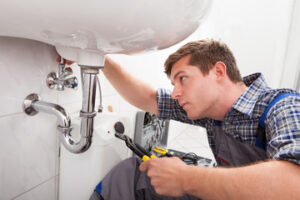Residential plumbers focus on plumbing systems in residential settings. Their responsibilities include interpreting blueprints and building plans, installing water heaters and appliances, and troubleshooting plumbing issues.

Commercial plumbers work in office buildings, hospitals, restaurants, and other non-residential spaces. They are more likely to work on bigger pipes and complex plumbing equipment. Contact Plumber Provo for professional help.
Plumbing is a vital part of the infrastructure that facilitates clean water supply, drainage, and waste disposal in homes and other buildings. Plumbers install, repair, and maintain these systems to ensure they are functioning correctly and safely. A career in plumbing requires years of education and training to learn the skills necessary for the job. In addition to mastering the art of installing and maintaining plumbing systems, plumbers must also understand the local codes and regulations that govern their profession.
Licensed residential plumbers can perform installation services in both new and existing homes. They can replace or upgrade toilets, faucets, garbage disposals, showers, and other fixtures. They can also perform complete home re-pipes to improve water and sewer system efficiency.
Residential plumbers use a variety of materials to assemble pipe systems, fittings, and valves. They may use equipment like cutting torches and threading machines. In addition, they inspect plumbing systems for leaks and other problems. If a problem is discovered, they must know how to repair or replace the affected component quickly and efficiently.
Another important service offered by residential plumbers is water filtration system installation. This service can reduce the amount of minerals and other impurities in household water, which can damage pipes and lead to clogs. Residential plumbers can also install backflow preventers to keep contaminated water from flowing into the potable water supply.
Commercial and industrial plumbing involves the installation, repair, and maintenance of plumbing systems in large buildings such as offices, malls, hospitals, and warehouses. It is different from residential plumbing because it deals with larger spaces that serve many people at once. Moreover, it is regulated by governmental agencies, which can have more stringent requirements and specified work hours.
Plumbing issues in a commercial space are often more complex to solve than those in a residential space. For example, if a building has multiple water leaks, it can be difficult to determine where the issue originates. This can be a time-consuming process, especially when the problem is located in areas with high usage. It can also be more challenging to diagnose and fix if the plumbing system is shared between multiple tenants.
Repair
Residential plumbers repair plumbing fixtures and systems in homes. These include toilets, sinks, bathtubs, showers, water heaters, and garbage disposals. They also inspect plumbing systems to ensure they are functioning properly. They can troubleshoot issues like clogged drains and toilets, low water pressure, and temperature fluctuations. They use specialized tools to repair and unclog pipes and fixtures, as well as replace them when necessary.
Residential plumbing can be more complex than commercial, so it’s important to hire a plumber with the right experience. Check their licenses and reviews to make sure they have the skills and knowledge to handle your specific needs. It’s also a good idea to get a residential plumber to service your home every two years. This will help prevent problems from occurring in the future.
Another service that residential plumbers offer is sewer line repairs and replacements. This is a more serious job than most homeowners are prepared to take on themselves. It’s best to leave this task to a professional, as it can be dangerous if you don’t know what you’re doing.
Plumbing leaks are one of the most common problems in homes and should be fixed as soon as possible. If left unattended, they can cause damage to the walls, floors, and ceilings of a house. This can lead to costly repairs and renovations. A residential plumber will be able to fix these leaks quickly and effectively.
Leaks in a home’s sewer system can be caused by tree roots, frozen water, or even just ageing pipes. If you suspect that your sewer lines are leaking, call a plumber immediately to avoid costly repairs.
Residential plumbers are trained to deal with all types of plumbing problems in homes. From a clogged toilet to a faulty water heater, they can tackle any issue that arises in your household. Their expertise can save you a lot of time, money, and stress. They can also give you advice on how to maintain your plumbing system and prevent future problems. They can also advise you on the best appliances and fixtures to buy for your home.
Maintenance
Although most homeowners don’t give plumbing systems much thought until something goes wrong, it’s a good idea to hire licensed plumbers to perform regular maintenance. This includes inspections for water leaks and other problems, as well as cleaning drain lines to prevent clogs. The plumber can also suggest upgrades and replacements for fixtures, appliances, and pipes to ensure they’re functioning properly and efficiently.
Residential plumbers often have to work with a wide variety of materials and tools, including copper, PVC, cast iron, and stainless steel. They also need to be familiar with blueprints and building codes in order to correctly install and connect pipes, fixtures, and appliances. In addition, they may be required to operate power tools and cutting torches for tasks like opening walls and floors.
Some of the most common plumbing issues that homeowners encounter are sewer backups, running toilets, and low water pressure. Leaking pipes and fixtures are also common, and can lead to expensive damage if not addressed quickly. A trained plumber will be able to diagnose and fix these problems quickly, before they worsen.
When choosing a plumber, it’s important to find out whether they have experience working in commercial or residential settings. Residential plumbers typically only work on home plumbing systems, while commercial plumbers are more likely to focus on larger buildings such as offices, hospitals, and malls. In addition, it’s important to find out whether the plumber is licensed and insured.
A licensed plumber should be able to provide you with a list of references from past clients. This will help you gauge their level of service and professionalism. It’s also a good idea to ask the plumber about their pricing structure and whether they charge by the hour or by the job.
While many people don’t think about the difference between a commercial and residential plumbing system, it’s crucial that you choose the right one for your needs. A professional with a license can handle both types of projects, while an unlicensed plumber could end up costing you more in the long run. Make sure to find out what type of services the plumber provides and if they offer any discounts for new customers.
Replacement
The supply pipes in a house can last between 70 and 100 years, depending on the material they’re made of. But when a pipe gets clogged or bursts, you need a plumber to replace it. Plumbing companies usually offer a bundled service that includes inspection, maintenance, repair and replacement of various parts in a plumbing system.
A residential plumber can also install water heaters, garbage disposal units and whole house re-pipes. They can even repair or replace toilets, faucets, showers, tubs and washers. Some companies may even offer emergency services to address urgent problems.
Most plumbers get their training through an apprenticeship program. An apprentice learns the trade by working alongside experienced plumbers under their supervision. Some apprenticeship programs last for three to four years. After their apprenticeship is complete, the plumber receives a certificate and can work independently.
Licensed plumbers can be found working at construction sites, office buildings, malls and hospitals. They can install new plumbing systems by interpreting blueprints and building specifications and connecting water supplies to fixtures. They can also inspect drainage systems to identify and resolve problems.
Commercial plumbing is more complex than residential plumbing. For example, a plumber working on a large public plumbing system in a school or hospital has to deal with multiple sinks, toilets and floors. In addition, these systems must be connected to larger industrial equipment.
Plumbing services at home or in the office require regular maintenance to keep everything running smoothly. But most people don’t have the time to do this themselves, and that’s where a professional plumber comes in. A plumber can check for any leaks or clogs, and fix them before they become bigger issues.
In some countries, the law requires that a licensed plumber perform routine inspections of all plumbing systems at least once a year. This is to ensure that all fixtures are in good condition and that the water supply is safe. A plumber can also advise property owners on ways to reduce their utility bills through better water conservation. Moreover, they can offer advice on installing solar panels and rainwater harvesting systems.



